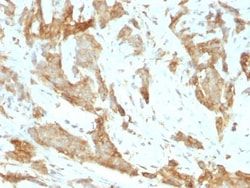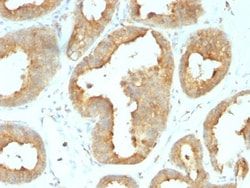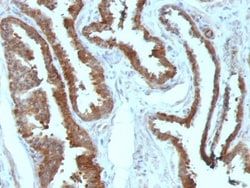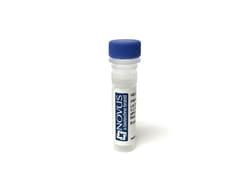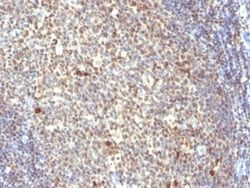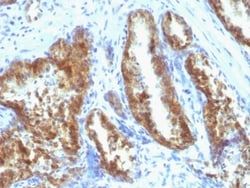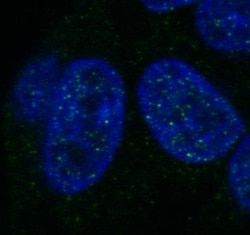gp96/HSP90B1/GRP94 Antibody (SPM249), Novus Biologicals™
Rat Monoclonal Antibody has been used in 1 publication
Manufacturer: Fischer Scientific
The price for this product is unavailable. Please request a quote
Antigen
gp96/HSP90B1/GRP94
Concentration
0.2mg/mL
Applications
Western Blot, Flow Cytometry, Immunohistochemistry (Paraffin), Immunofluorescence
Conjugate
Unconjugated
Host Species
Rat
Research Discipline
Cancer, Cellular Markers, ER Markers, Golgi Apparatus Markers, Hypoxia, Membrane Trafficking and Chaperones
Formulation
10mM PBS and 0.05% BSA with 0.05% Sodium Azide
Gene ID (Entrez)
7184
Immunogen
Purified glucose regulated protein 94 (grp94) from chicken oviducts
Primary or Secondary
Primary
Content And Storage
Store at 4C.
Molecular Weight of Antigen
94 kDa
Clone
SPM249
Dilution
Western Blot 0.5 - 1.0 ug/ml, Flow Cytometry 0.5 - 1 ug/million cells in 0.1 ml, Immunohistochemistry-Paraffin 0.5 - 1.0 ug/ml, Immunofluorescence 0.5 - 1.0 ug/ml
Classification
Monoclonal
Form
Purified
Regulatory Status
RUO
Target Species
Human, Mouse, Rat, Porcine, Canine, Chicken, Equine, Guinea Pig, Hamster, Monkey, Primate, Rabbit, Sheep, Xenopus species
Gene Alias
94 kDa glucose-regulated protein, endothelial cell (HBMEC) glycoprotein, glucose regulated protein, 94 kDa, GP96ECGP, GRP-94, GRP94gp96 homolog, Heat shock protein 90 kDa beta member 1, heat shock protein 90kDa beta (Grp94), member 1, TRA1endoplasmin, tumor rejection antigen (gp96) 1, Tumor rejection antigen 1, Tumor rejection antigen-1 (gp96)
Gene Symbols
HSP90B1
Isotype
IgG2a κ
Purification Method
Protein A or G purified
Test Specificity
Recognizes a protein of 94kDa, which is identified as the glucose-regulated protein 94 (grp94) and also tumor rejection antigen (gp96). Grp94 shows a high degree of sequence homology with the heat shock protein 90 (hsp90). This MAb is highly specific to grp94 and shows minimal cross-reaction with other members of the HSP90 family. Grp s are a class of proteins unresponsive to heat shock and are induced by glucose deprivation. Grp94 has been briefly studied as a prognostic factor in breast cancer.
Description
- Ensure accurate, reproducible results in Western Blot, Flow Cytometry, Immunohistochemistry (Paraffin), Immunofluorescence gp96/HSP90B1/GRP94 Monoclonal specifically detects gp96/HSP90B1/GRP94 in Human, Mouse, Rat, Porcine, Bovine, Canine, Chicken, Equine, Guinea Pig, Hamster, Monkey, Rabbit, Sheep, Xenopus samples
- It is validated for Western Blot, Flow Cytometry, Immunohistochemistry, Immunocytochemistry/Immunofluorescence, Immunohistochemistry-Paraffin.
